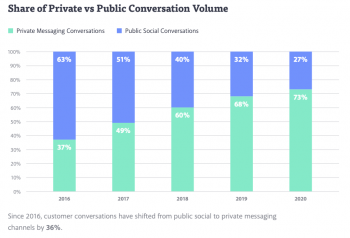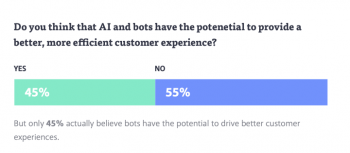In a tumultuous year, we’ve seen customer expectations change beyond recognition.
We are yet to define what a new ‘new normal’ will look like beyond the Covid pandemic, but we are beginning to get a better understanding of how it’s shaping up.
Each year Conversocial publishes a State of CX Trends Report to give a snapshot of how consumer behaviour and attitudes are shifting. This year we analysed data from our own partners, as well as conducting surveys of consumers and CX professionals to gain insight into the CX landscape over the past 12 months. Here are 5 of the most interesting insights from this year’s report.
1. 69% of consumers communicated with brands over private messaging channels
This represents a 13% rise year-on-year compared to 2019. Some of this is obviously down to there being few chances for any kind of in-person engagement, but more can be learned from the data we found analyzing the interactions between Conversocial’s partners and their customers. Private messaging conversations grew by 87% year on year compared to 2019, far outstripping public social interactions 73% to 27%.
It’s not just that consumers are turning to digital solutions to interact with brands, the majority of conversations are happening on private channels like WhatsApp, Facebook Messenger and Apple Business Chat.

2. Great CX is the most important factor for customer loyalty
We even found that exceptional experiences (28%) has overtaken quality of product (23%) and competitive pricing (24%), as the most influential factor in customer retention. Existing customers are more likely to buy from a brand than new ones, and 80% of consumers actually want businesses to directly communicate with them after a sale.
This reflects the increased expectations that people have of their favorite brands, with 70% also saying they have stopped doing business with a company following a poor experience. It’s never been more vital to ensure that each and every touchpoint a customer has with your brand is maximized to enhance the experience. Personalization, ease of use and convenience is the order of the day.

As a modern solution, private messaging channels work better than any other form of customer interaction platform. The reach of platforms like WhatsApp and Facebook Messenger are huge, with 2bn and 1.3bn users respectively. These apps are part of people’s daily routines, WhatsApp alone delivers 100bn messages a day, and as a result, offer far higher engagement than traditional forms of digital engagement, like email or SMS.
3. 81% of consumers expect brands to engage them using private messaging channels
The change in consumer behaviour is backed up by a survey we conducted last year, which showed consumers were keen to continue online shopping, appointment booking and using click-and-collect services post-Covid. This doesn’t mean that they’re willing to accept inferior experiences just because everything is becoming digital. If anything, expectations of digital CX are growing. This year’s State of CX Trends Report found that 81% of consumers expect to be able to engage brands using private messaging channels and 88% are more likely to become repeat customers after experiencing great CX over those channels.
Clearly there are rising expectations of how accessible a brand is and, increasingly, consumers want to interact on their own terms.
4. 69% of people would use a bot if it improved their experience or answered questions quicker
A curious contrast that emerged in our consumer survey is that 69% of people would happily use a bot if it improved their customer experience or answered their questions quicker, but 55% don’t believe that AI and bots are able to perform those duties. It’s not that automation is bad for CX, there are just too many badly designed bots ruining it for the good ones.

So how can brands utilize private messaging channels to deliver great CX? The short answer is: automation. The slightly longer answer: automation that has great conversational design. As bots become a larger part of the mainstream customer experience, customers recognize the benefits of automation, it’s up to brands to catch up and capitalize on this shift in attitude. It’s about designing the best conversational experience and applying it to the correct experience. Bots provide speed, ease of use and convenience, but the lack of human touch and personalization means they’re ideal for taking payments or order tracking, but not dealing with more complex issues.
5. 79% of brands know automation will play an important role in CX delivery over the next 12 months
The appetite is clearly there for smooth automated conversations, but there’s an issue with brands’ ability to deliver them. If you look at our survey of CX professionals, the picture becomes a little clearer. 79% of brands know that automation will play an important role in CX delivery in the next 12 months, but it doesn’t mean they’re getting themselves ready to capitalize on automation’s potential. Less than 50% are investing heavily in it and even less have advanced automation in place in their CX operations. Budget restrictions, a lack of understanding and legacy tech are all standing in the way of brands being able to deliver the best automated CX over messaging channels their customers demand.

How can brands capitalize on the power of messaging channels to improve CX?
It starts with one simple use case. By identifying a common intent and designing a conversation that turns it into a seamless brand/consumer interaction, brands can start to better understand how to navigate the automation space without falling into the trap of becoming robotic. It’s the only way they will be able to turn the 55% of doubters into believers, loyal to their brand.



